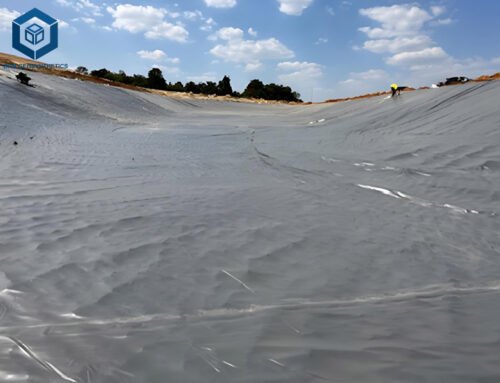Geo geocell, also known as cellular confinement systems (CCS), is innovative geosynthetic materials revolutionizing civil engineering, environmental protection, and infrastructure development. These three-dimensional, honeycomb-like structures are typically made from high-density polyethylene (HDPE) or novel polymeric alloys (NPA) and are filled with materials such as soil, gravel, or concrete to stabilize soil, control erosion, and support heavy loads. Since their development by the U.S. Army Corps of Engineers in the 1970s for tactical road construction over soft soils, geocells have evolved into versatile solutions used globally in applications ranging from slope protection to roadway stabilization.
Geo geocells play a significant role due to their cost-effectiveness and sustainability (MarketsandMarkets, 2024). Geocells reduce material usage by up to 50% compared to traditional methods, lower installation costs, and enhance environmental outcomes by minimizing erosion and enabling the use of local fill materials. This article provides a comprehensive exploration of geo geocells, including their specifications, types, applications, and effectiveness, offering valuable insights for engineers, contractors, and project managers.
1. What Is Geo Geocell?
Definition and Composition
Geo geocell is a geosynthetic material consisting of interconnected, three-dimensional cells that form a flexible, honeycomb-like structure when expanded. Typically manufactured from HDPE, geocells are ultrasonically welded or bonded to create a durable matrix that confines infill materials such as soil, sand, gravel, or concrete. The confinement enhances the shear strength and load-bearing capacity of the infill, reducing lateral movement and improving structural stability. Geocells are supplied in collapsed panels for easy transport and expand on-site to cover areas up to 230 m² per panel (e.g., 8.4 m x 27.4 m).
The material composition includes:
- HDPE (High-Density Polyethylene): 95–98% of the structure, providing high tensile strength (≥20 MPa, ASTM D638) and durability.
- Additives: Carbon black (2–3%) for UV resistance, antioxidants to prevent degradation, and stabilizers for thermal resistance.
- Perforations (Optional): Allow water and nutrient flow, enhancing vegetation growth in erosion control applications.
Geocells were first developed in the 1970s by the U.S. Army Corps of Engineers to build temporary roads over soft soils. Their commercial adoption, led by companies like Presto Geosystems with the Geoweb® system, expanded their use to civil and environmental applications by the 1980s.
How Geocells Work
Geocells function by confining infill materials within their cellular structure, distributing applied loads over a wider area and reducing stress on the subgrade. The confinement mechanism increases the shear strength of the infill by up to 50% and reduces deformation by 30% compared to unreinforced soil (Bathurst and Jarrett, 1988). For example, in load support applications, geocells create a “mattress effect,” spreading vertical loads laterally to prevent rutting and settlement. In erosion control, the cells act as mini-weirs, reducing runoff velocity and preventing soil displacement.
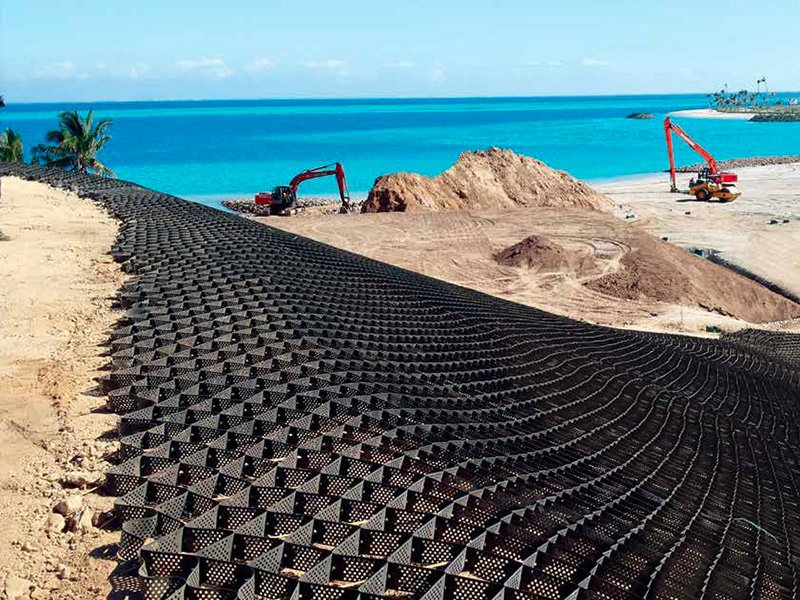
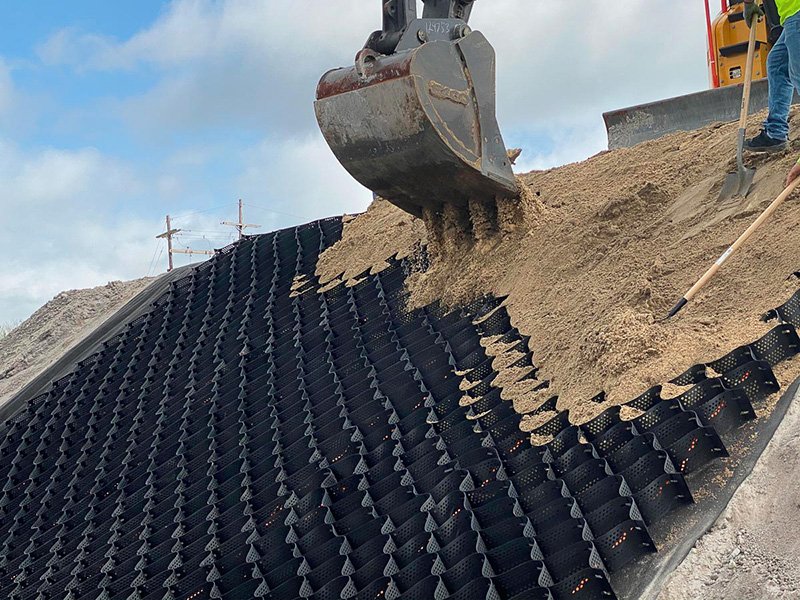
2. Key Features of Geo Geocell
Geocells are engineered with features that enhance their performance across diverse applications. Below are the primary features, supported by technical data:
High Tensile Strength
Geocells exhibit tensile strengths of 20–30 MPa (ASTM D638), enabling them to withstand heavy loads and stresses. For example, BaseCore HD geocells support up to 400 kg/m² without subgrade damage, making them suitable for heavy-duty applications like roadways and parking lots.
Permeability and Drainage
Perforated geocells, with 10–20% of their wall area perforated, allow water, air, and nutrients to flow through, reducing runoff and promoting vegetation growth. Non-perforated geocells provide a solid barrier for applications requiring containment, such as retaining walls. Permeable geocells reduce runoff velocity by 50–70% on slopes up to 60°.
Durability and UV Resistance
Made from UV-stabilized HDPE, geocells retain ≥80% of their strength after 1,600 hours of UV exposure (ASTM D7238). This ensures a lifespan of 20–50 years in exposed conditions and up to 100 years when covered, as seen in projects like the Milford Haven Oil Refinery lagoon stabilization.
Flexibility and Conformability
Geocells are flexible, conforming to irregular terrain and reducing site preparation time by 20–30%. Their lightweight nature (e.g., 11 kg for a 2-inch geocell covering 160 ft²) simplifies handling and installation.
Cost-Effectiveness
Geocells reduce material requirements by up to 50% compared to traditional aggregates and lower installation costs by 20% due to rapid deployment. For example, a 10,000 m² roadway project using 4-inch geocells saves approximately $25,000 in aggregate costs.
Environmental Sustainability
Geocells enable the use of local or recycled infill, reducing quarrying and transportation emissions by 30%. Their recyclability and low carbon footprint (40% less than concrete) align with sustainable construction practices.
3. What Are Types of Geo Geocell?
Geocells are categorized based on material, cell wall design, and intended application. Below are the primary types:
HDPE Geocells
The most common type, HDPE geocells are made from high-density polyethylene and account for 80% of geocell applications due to their affordability and durability. They are available in perforated and non-perforated variants, with cell depths ranging from 50 mm (2 inches) to 200 mm (8 inches).
Novel Polymeric Alloy (NPA) Geocells
NPA geocells, such as PRS-Neoweb, use advanced polymer alloys for higher stiffness and strength at thinner gauges. They are 20–30% more expensive but offer superior performance in high-load applications like railbeds, supporting up to 500 kN/m².
Fabric Geocells
Made from permeable geotextile fabrics (e.g., TERRAM Geocells), these are used for erosion control and tree root protection. Their permeability enhances drainage and vegetation, making them ideal for slopes up to 45° and landscaping projects.
Perforated vs. Non-Perforated Geocells
- Perforated Geocells: Feature holes (10–20% of wall area) for drainage and root interlocking, used in erosion control and green infrastructure. They reduce runoff by 60% on slopes.
- Non-Perforated Geocells: Solid-walled for maximum confinement, used in load support and retaining walls. They provide 20% higher shear strength than perforated variants.
4. Key Difference Of Types of Geo Geocell
The differences between geocell types impact their suitability for specific applications. Below is a detailed comparison:
Material Composition:
- HDPE: Cost-effective, with tensile strength of 20–30 MPa. Ideal for general-purpose applications like roadways and slopes.
- NPA: Higher elastic modulus (up to 1,000 MPa vs. 400 MPa for HDPE), offering better load distribution for heavy-duty projects like railways.
- Fabric: Permeable, with lower tensile strength (10–15 MPa) but superior drainage for vegetation-based applications.
Cell Wall Design:
- Perforated: Enhances drainage and vegetation, reducing runoff velocity by 50–70%. Best for slopes and channels with flow velocities up to 6 m/s.
- Non-Perforated: Maximizes confinement, increasing shear strength by 20%. Preferred for load support and retaining walls.
Cost:
- HDPE: $1.50–$3.00/m², widely available.
- NPA: $3.50–$5.00/m², higher cost due to advanced materials.
- Fabric: $2.00–$4.00/m², cost-effective for landscaping but limited in heavy-load applications,.
Applications:
- HDPE: Versatile for erosion control, load support, and retaining walls.
- NPA: Specialized for high-load scenarios like railbeds and heavy equipment pads.
- Fabric: Focused on erosion control and tree root protection, less suitable for heavy loads.
5. What Is The Thickness of Geo Geocell (mm, mils, and Micron)?
Geocell thickness refers to both cell depth and cell wall thickness, which determine load capacity and durability.
Cell Depth
Cell depth varies based on application:
- 2 inches (50 mm, 1,969 mils, 50,000 microns): For light-duty applications like pedestrian pathways and erosion control. Load capacity: 8,000 lbs (3,629 kg).
- 3 inches (75 mm, 2,953 mils, 75,000 microns): For moderate loads like driveways and light vehicle traffic. Load capacity: 10,000 lbs (4,536 kg).
- 4 inches (100 mm, 3,937 mils, 100,000 microns): For roadways and medium-duty applications. Load capacity: 12,000 lbs (5,443 kg).
- 6 inches (150 mm, 5,906 mils, 150,000 microns): For heavy-duty roads and equipment pads. Load capacity: 15,000 lbs (6,804 kg).
- 8 inches (200 mm, 7,874 mils, 200,000 microns): For industrial applications like truck parking and railbeds. Load capacity: 20,000 lbs (9,072 kg).
Cell Wall Thickness
Cell wall thickness typically ranges from 1.2 mm to 2.0 mm (47–79 mils, 1,200–2,000 microns):
- 2 mm (47 mils, 1,200 microns): Standard for light-duty geocells, offering cost savings but lower stiffness.
- 5 mm (59 mils, 1,500 microns): Common for medium-duty applications, balancing cost and strength.
- 0 mm (79 mils, 2,000 microns): Used in heavy-duty geocells like BaseCore HD, providing 20% higher bending stiffness.
For example, a 4-inch geocell with 1.5 mm walls supports 12,000 lbs, while an 8-inch geocell with 2.0 mm walls supports 20,000 lbs, making it ideal for heavy industrial use.
6. Main Considerations When Choosing Geo Geocell
Selecting the appropriate geocell involves evaluating project-specific factors to ensure performance and cost-efficiency. Below are key considerations:
Application Type
- Erosion Control: Perforated geocells with 2–4-inch depths are ideal for slopes up to 60° and channels with flow velocities up to 6 m/s. Use vegetated soil or gravel infill.
- Load Support: Non-perforated geocells with 4–8-inch depths suit roadways and heavy equipment pads. Use compacted gravel (3/8–3/4 inch) to avoid sinking.
- Retaining Walls: Non-perforated HDPE or NPA geocells with 6–8-inch depths provide structural stability for walls up to 70°.
Soil Conditions
Weak or soft soils (e.g., CBR <4) require deeper geocells (6–8 inches) to create a mattress effect, increasing load distribution by 30%. Stable soils can use 2–4-inch geocells for cost savings.
Load Requirements
Match cell depth to load:
- Light traffic (pedestrian): 2-inch geocells.
- Medium traffic (vehicles): 4-inch geocells.
- Heavy traffic (trucks, rail): 6–8-inch geocells.
Infill Material
- Gravel (3/8–3/4 inch): Best for load support, providing 20% higher shear strength than rounded pea gravel.
- Soil/Vegetation: Ideal for erosion control, promoting root interlocking and reducing runoff by 60%.
- Concrete: Used for high-flow channels (>6 m/s) and permanent structures, eliminating the need for wood forms.
Drainage Needs
Perforated geocells are essential for applications requiring drainage, such as slopes and channels, reducing runoff by 50–70%. Non-perforated geocells suit dry environments or containment applications.
Budget and Availability
HDPE geocells ($1.50–$3.00/m²) are cost-effective for most projects, while NPA geocells ($3.50–$5.00/m²) are justified for high-load applications. Local sourcing reduces freight costs by 15%.
Environmental Factors
UV-stabilized geocells are critical for exposed applications, retaining ≥80% strength after 1,600 hours of UV exposure. For aesthetic integration, green or brown geocells blend with landscapes.
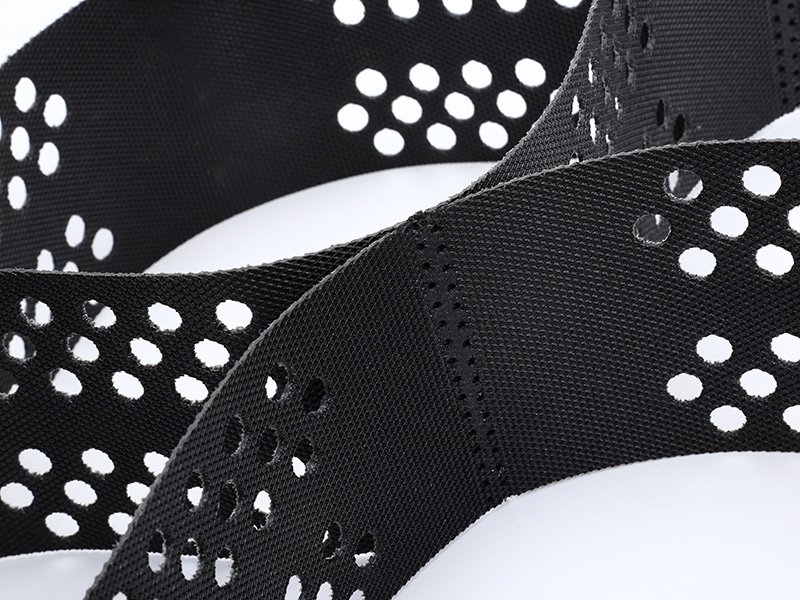
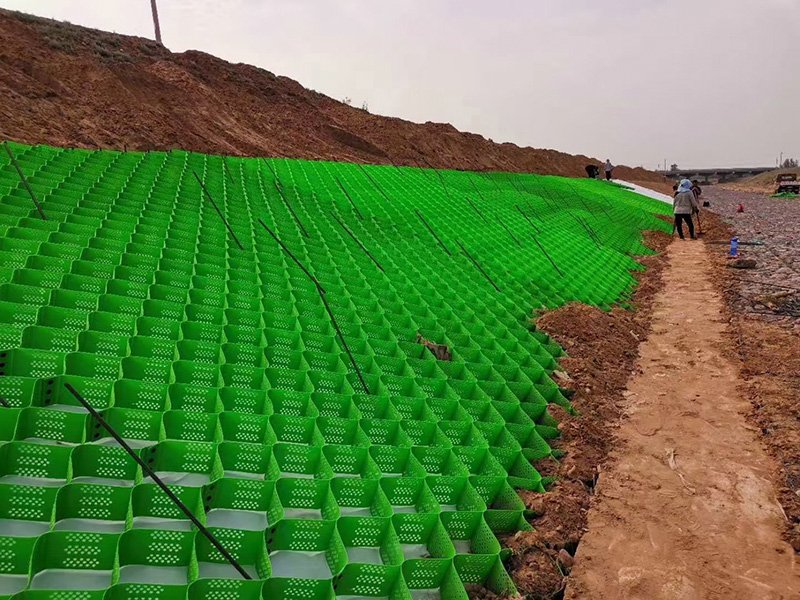
7. Is Geo Geocell Effective for Erosion Control?
Mechanism of Erosion Control
Geocells are highly effective for erosion control, reducing soil loss by 90–95% on slopes up to 60° and in channels with flow velocities up to 7.6 m/s (BaseLok™ GeoCell). The cellular structure confines infill, preventing lateral movement and acting as mini-weirs to reduce runoff velocity by 50–70%. Perforated walls enhance root interlocking, increasing vegetation stability by 30% and reducing the impact of raindrops and hydraulic shear stresses.
Performance Data
- Slope Protection: A 2021 study showed that geocells with vegetated infill reduced soil loss by 92% on a 45° slope under simulated rainfall (Song et al., 2021).
- Channel Protection: Geocells with concrete infill withstand flow velocities >7.6 m/s, compared to 3 m/s for unreinforced soil, preventing rill and gully formation.
- Cost Savings: Geocells reduce material requirements by 50% compared to traditional riprap, saving $10,000–$20,000 for a 5,000 m² slope project.
Case Studies
- M25 Embankment, UK: TERRAM Geocells prevented embankment erosion on a 30° slope, reducing maintenance costs by 25% over 5 years.
- Thailand Slope Stabilization: Geocells with wheat straw infill reduced erosion by 90% on a residual soil slope under heavy rainfall (Nguyen et al., 2020).
Limitations
Geocells are less effective on slopes >70° without additional anchoring (e.g., tendons or EnviroClip™ anchors). In high-flow channels (>7.6 m/s), concrete infill is required to prevent washout.
8. What Is Geo Geocell Used For?
Geocells are versatile, addressing multiple engineering challenges. Below are the primary applications, supported by examples and data.
Slope and Channel Protection
Geocells stabilize slopes up to 60° and channels with flow velocities up to 7.6 m/s, reducing erosion by 90–95%. Infill options include vegetated soil (for slopes <20°), gravel (for velocities <3 m/s), or concrete (for velocities >6 m/s). A 2023 project in Canada used Geoweb® geocells to stabilize a 45° slope, saving 30% in material costs compared to riprap.
Load Support and Roadway Stabilization
Geocells reinforce weak subgrades (CBR <4), reducing aggregate thickness by 50% and supporting loads up to 20,000 lbs. A 2024 roadway project in Australia used 6-inch BaseCore HD geocells, extending pavement life by 10 years.
Retaining Walls
Geocells form flexible retaining walls for slopes up to 70°, resisting seismic forces and reducing construction costs by 20% compared to concrete walls. A 2023 project in Japan used geocells for a railway embankment, improving stability by 25%.
Green Infrastructure and Landscaping
Perforated geocells promote vegetation, used in green roofs, tree root protection, and landscaping. A 2024 project in Sheffield, UK, used TERRAM Geocells for a green bund system, enhancing aesthetics and reducing runoff by 60%.
Mining and Containment
Geocells provide secondary containment in mining operations, preventing chemical leaching. A 2025 project in Chile used 8-inch geocells for a tailings pond, achieving 99% containment efficiency.
Flood Control
Geocells offer a faster alternative to sandbags, deployable in hours. A 2024 flood control project in the US used TYPAR Geocells, reducing deployment time by 50%.
9. Conclusion
Geo geocells are transformative geosynthetic solutions, offering unmatched versatility, durability, and cost-effectiveness in civil and environmental engineering. With tensile strengths of 20–30 MPa, lifespans of 20–50 years, and the ability to reduce material usage by 50%, geocells excel in erosion control, load support, and retaining wall applications. Their types—HDPE, NPA, and fabric—cater to diverse needs, from heavy-duty railbeds to aesthetic landscaping. Key considerations like cell depth (2–8 inches), infill type, and drainage requirements ensure optimal performance. For erosion control, geocells reduce soil loss by 90–95%, making them a superior alternative to traditional methods.
Project managers and engineers can maximize benefits by selecting the appropriate geocell type, depth, and infill based on site conditions and load requirements. Cost-saving strategies, such as using local infill and automated installation, can reduce expenses by 20–30%. As the geosynthetics market grows, innovations like conductive geocells and recycled materials will further enhance sustainability. For reliable geocell solutions, contact suppliers like BPM Geosynthetics, offering ISO-certified products and technical support for projects worldwide.

